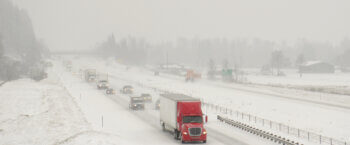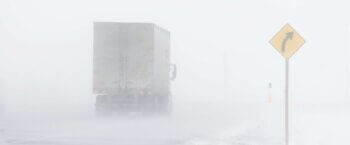
Slow Your Roll: The Ultimate Winter Driving & Preparation Guide

Don’t hit the road unprepared.
Download the full guide to tackle winter’s toughest driving challenges with confidence.
By downloading this guide you, agree to Truckstop’s Terms and Conditions and Privacy Policy.
Every trucker knows that winter weather driving requires preparation and the ability to adapt quickly to whatever comes your way. No matter how many seasons you’ve got under your belt, preparing for winter driving can feel a little daunting. You stock up on emergency supplies, check your chains, and triple-check your antifreeze levels – but there’s always that nagging voice in the back of your mind wondering what curve ball Mother Nature might throw your way.
According to the Federal Highway Administration, over 1,300 people die annually in vehicle crashes on snowy or icy roads. Even more telling: 24% of weather-related crashes occur on snowy or icy pavement. These stats only emphasize the importance of being prepared and going through your winter weather checklist early and often.
Winter toolkit basics
Mentally preparing for winter
Although equipment and supplies are crucial for winter weather driving, mental preparedness is equally important. Winter driving isn’t just about skill – it’s about mindset.
- Know your limits: There’s no load worth your life. Learn to recognize when conditions exceed your comfort zone.
- Manage pressure: Customers and brokers may push for delivery, but you’re the one behind the wheel. Trust your judgment.
- Stay flexible: Winter requires adaptability. Build extra time into your schedule and have backup plans.
Organize your winter toolkit
The trick isn’t just having the right equipment and supplies; it’s having them organized and accessible when you need them most. That extra flashlight won’t help much if it’s buried under your bunk when you’re stuck in a whiteout. Every item in your winter kit should earn its space in your truck, and you should know exactly where to find it when you need it.
Break down your winter weather driving supplies.
Your winter weather driving supplies can be broken down into three categories:
- Immediate access: Items you might need in seconds (flashlight, basic tools, extra gloves)
- Quick grab: Things you need within a few minutes (extra clothes, emergency food)
- Extended emergency: Supplies for longer situations (additional food, repair tools)
The goal is smart preparation that doesn’t compromise your payload or your efficiency. Every item should serve a clear purpose, and ideally, many should have multiple uses.

In-cab essentials
Prepare early, before winter weather hits, and stow the essentials in a backpack under your seat or in a box or duffel bag in your cab or sleeping berth. If you start early, you’ll be less likely to forget things and you can add items as you think of them. If you find yourself stuck, it’s always better to be over-prepared. Better safe than sorry!
Warm clothing and extra blankets
Pack several changes of clothing so you’ll never run out of dry options. Layers are always a good idea. Lightweight thermals and water wicking layers, down and down alternative coats that compress into small spaces, and waterproof outer layers are smart choices. You should also have at least one extra pair of boots made especially for snow.
Extra socks made for winter weather (like wool socks that keep your feet dry and warm), extra gloves, a winter hat, and at least one or two extra blankets will prepare you for the elements. Several thinner blankets hold warmth better than one thick blanket, plus you can layer as needed.
Non-perishable food and water
Always carry a supply of drinking water to stay hydrated in case of an emergency, as well as non-perishable food items like dried fruit, nuts, peanut butter, granola bars, energy bars, and jerky, canned tuna, or chicken for protein.
Portable heating devices and fuel
In case you find yourself hunkering down in your truck cab for an extended period, make sure you have heat sources other than your truck so you can preserve as much fuel as possible. Consider keeping small electric blankets. Hand and feet warmers might also come in handy.
Personal hygiene items and medications
If you need any prescription medications, pack extra in case your trip extends unexpectedly and you’re unable to get to a pharmacy. Stash an additional pair of glasses or contacts, along with toiletries like toothpaste and a toothbrush, sunscreen, deodorant, and chapstick.
First aid kit
Keep a fully stocked first aid kit with over-the-counter pain medication, cold medicine, bandaids and bandages, and antibiotic ointment.
Emergency communication tools
In case you find yourself without cell service, make sure you’re equipped with alternative ways to reach out and communicate, whether you need to reach your customer, your family, or emergency personnel or police.

Exterior must-haves
Trucking is not for the faint of heart under any circumstances, but add hazardous weather and treacherous road conditions, and you’ve got yourself a “situation.” From white-out blizzards to freezing rain to a stuck truck, if your truck is not ready to handle the worst-case scenario, you might find yourself frustrated at best and in danger at worst.
Take precautions beforehand, before that first snowflake falls or temps fall to freezing.
Snow chains or tire socks
Always carry tire chains in your truck and know how to put them on. They give you extra traction in heavy snow conditions and are required by law in some areas. Follow the manufacturer’s instructions for installation, and make sure you remove them as soon as they’re not necessary to avoid damaging both the roads and your tires.
Shovel and ice scraper
Don’t forget the basics! Make sure to bring a shovel for digging yourself out of a snowbank or removing snow from around your wheels and an ice scraper that can easily reach and handle your truck windows when they accumulate ice.
Cat litter or sand for traction
When you need extra traction, nothing beats a bag of cheap cat litter or sand. Sometimes that’s all it takes to get your truck out of a jam.
Emergency flares or reflective triangles
You should have these in your truck year-round, but especially in winter, when bad weather conditions are more likely to leave you stranded.
Extra fluids and additives
Extra windshield wiper fluid, diesel additives, and quality brand-name antifreeze should be purchased and stored in your truck in the event you need them and you can’t get to a store.
Basic tools for minor repairs
Get a small toolkit that takes up little space in case you need to make a minor repair. Always have an extra flashlight or two, jumper cables, and extra batteries on hand.

Chain laws and compliance
During winter weather, tire chains help prevent accidents. Losing traction on snow or ice, especially in a heavy vehicle that weighs over 10,000 lbs., can lead to dire circumstances.
Importance of chain laws
Chain laws vary by state, so know what’s required before you go. Knowing and complying with the legal requirements will help you avoid a pricey ticket or putting your CDL at risk. They also keep you and other drivers on the road safe in inclement weather and dangerous driving conditions.
How chain laws vary by state
Each state sets its own chain rules, and it’s important to know where and when to chain up to avoid fines.
Weather conditions and patterns in each state will determine what you’ll need and when. The states with the harshest weather tend to have the strictest laws.
For example, in Colorado, which averages 67 inches of snow every year, you are required to carry chains from September 1 to May 31. California doesn’t require chains to be carried during a specific timeframe, but drivers must put on chains when highway signs indicate chains are required.
Fines and penalties for non-compliance
Non-compliance fines range from $50 to $500. Getting caught without the required chains can result in a hefty fine, or worse, put you out of service until you resolve the situation.
Monitoring chain law alerts
Stay in the know by frequently checking the conditions and requirements in areas you’re driving. These resources can help keep you updated.
- Variable message signs (VMS): Most major freeways, highways, and main roads post the current chain requirements, so be on the lookout for these digital signs.
- State transportation texting systems: Sign up to receive chain law enforcement texts through the state transportation texting system in the state you’re in. You can also tune in to transportation radio stations to stay informed.
- Electronic logging devices: The best electronic logging devices (ELDs) provide features that help keep you safe on the road in addition to logging your HOS. Get one that goes above and beyond to keep you informed of winter weather driving conditions and chain requirements in the lane you’re driving.
- Dispatch communications. If you work with a dispatch service, they can also keep you apprised of road conditions and chain requirements.
Install chains correctly and safely
Having chains on board is one thing, but knowing how to install them quickly and properly will give you the confidence you need to tackle the road ahead. As soon as weather indicates or chains are required, pull over in a safe area and get it done. It’s best to put the chains on your truck before temperatures get lower and poor visibility hinders the process. Keep the manufacturer’s instructions on hand, but it’s a good idea to practice beforehand and get the process down.
- Examine chains before installing them: Orient your fasteners facing up and away from the tire and lay them out where you can see them. Make sure the tensioners are in the open position.
- Drape chains over tires: Drape chains over all four of the outer drive tires and center each chain so equal lengths hang over each side of the tire.
- Connect chains loosely: This can be tricky, but connect the chains loosely around each tire. You can use a stick or a tool to help make it easier. Make sure there’s an equal number of links on the inside and outside connection.
- Drive forward slightly: Once the chains are loosely connected, drive forward a few inches to place the connectors toward the top of the tire.
- Tighten chains properly: Chains should be snug, but not too tight. Use a tightening tool to crank tensioners if you need to. Your finger should fit between the chain and the tire.
- Follow precautions for chain usage: Tire chains should only be used when there’s ice or snow on the road and when chain alerts are active. Using chains on bare or wet roads can damage the road as well as your tires.
Additional Winter Preparedness
Preparing your truck for winter safety goes beyond chains. Check your battery’s age, stock your cab with emergency supplies, and install an engine block heater if needed. Cover basic maintenance needs and make sure your truck’s gear is in good working order (like your windshield wipers, etc.).
How to stay safe in an emergency
If you get stuck, don’t panic. The bad conditions will pass, and if you’re prepared, comfortable, and warm, you’ll have a good story to tell.
If you do find yourself stuck due to icy conditions, blinding blizzard conditions, or other weather-induced circumstances, stay safe by following these basic safety precautions:
- Remain with your vehicle: Don’t abandon your truck unless you absolutely must—and stay inside your cab if you can to keep warm and dry!
- Keep exhaust pipe clear: Clear any snow off your exhaust pipe to prevent carbon monoxide poisoning. Hop out once in a while to make sure there’s no snow build-up.
- Conserve fuel while maintaining heat: Run your engine to stay warm, but do so sparingly to avoid running out of fuel.
- Communicate with dispatch and emergency services: Communicate regularly while preserving battery life. Use emergency communication devices if necessary.
- Signal for help: Use reflective materials and lights to signal you need help.
- Wait for safe conditions before driving: Put your safety over your schedule! An accident will only result in further delays and expenses—or worse! Better safe than sorry every time.
With proper preparation, caution, and awareness, you can handle winter driving more safely and with a higher degree of confidence.
Be winter ready.
Learn how to equip yourself and your truck to stay safe, prevent breakdowns, and keep moving through any winter storm.
Get the GuideWinter driving checklist for truck drivers
Pre-trip preparation
Vehicle preparation:
- Truck inspection: Make sure your truck is in top condition. Check brakes, tires, lights, and wipers.
- Fluids: Use winter-grade antifreeze and windshield washer fluid.
- Tires: Make sure your tires have proper tread depth and are inflated to the correct pressure. Use snow tires and chains when needed and required.
- Fuel: Keep your fuel tanks at least half full to prevent the fuel lines from freezing.
- Emergency kit: Equip your truck with an emergency kit that contains a flashlight, blankets, first aid kit, tire chains, and a shovel.
Personal preparedness:
- Clothing: Pack multiple layers of warm clothing, smart wool socks, waterproof boots, and heavy-duty gloves.
- Food and water: Pack three days’ worth of non-perishable food and one gallon of water per day. Include high-energy snacks.
Emergency Gear:
- Communication: Keep a battery-powered or hand-crank radio in case you lose cell service.
- Tools: Have a multi-tool, basic tool kit, jump starter with USB ports, and flashlights with extra batteries.
- Traction: Snow chains, or tire socks, a shovel, and cat litter or sand can be useful for a variety of circumstances.
- Safety: Keep emergency flares, LED beacons, and/or reflective triangles in your truck for emergencies.
Practice safe driving techniques
- Increase following distance: Snow and ice reduce traction, so give yourself plenty of room for extra stopping time. Remember, you can’t predict how other drivers will react to bad weather.
- Slow down: Drive cautiously and reduce your speed, especially on icy roads or during a snowstorm.
- Avoid sudden maneuvers: Gentle turns, braking, and acceleration will help avoid skidding.
- Use engine braking: When descending, use the engine brake instead of relying solely on the foot brake to avoid wheel lockup.
- Mind black ice: Watch out for black ice, which is hard to see but very dangerous. It often forms on bridges, overpasses, and in shaded areas.
- Stay off cruise control: In slippery conditions, avoid using cruise control, as it can cause unexpected acceleration.

Know the road conditions
- Check weather reports: Stay informed of road conditions and weather alerts before and during your trip.
- Use navigation apps: Use trucker-friendly GPS apps to get real-time updates on road conditions and potential hazards. Some essential apps might include:
- Weather Underground (detailed forecasts)
- Chain Law Pro (real-time chain requirements)
- Trucker Path (parking and road conditions)
- State DOT apps for your regular routes
- Stay on treated roads: Stick to main highways and roads that are more likely to be plowed and salted.
Be ready for delays
- Plan extra time: Winter driving often results in delays, so plan for additional travel time.
- Rest: Fatigue is dangerous, especially in winter conditions. Take regular breaks and stay alert.
- Be patient: It’s better to arrive late than take unnecessary risks on dangerous roads.
Communicate
- Stay connected: Keep your cell phone charged and have a backup battery or charger.
- CB radio: Use your CB radio to communicate with other drivers or alert authorities of road hazards or emergencies.
- Have help on standby: Keep the state highway patrol numbers for your regular routes, your company’s emergency response team, local heavy-duty towing services, and weather service hotlines saved in your phone.
In case of an emergency
- Stay with your vehicle: If you get stuck or break down, stay with the truck and avoid wandering off into the snow.
- Signal for help: Use your flashers and other emergency signals to let others know you’re in distress.
- Conserve fuel: If stranded, run the engine periodically to stay warm, but conserve fuel when possible.
Join Our Trusted Network
Help protect your business with the load board you can rely on.



